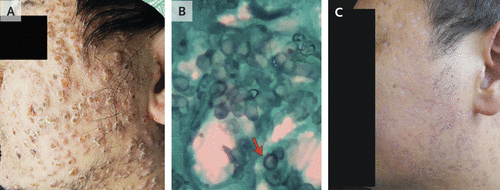
A 29-year-old man presented to an outpatient clinic with a 2-month history of fever, cough, dyspnea, and weight loss, as well as skin lesions that had developed on his face, neck, trunk, arms, and legs over a period of 2 weeks.
Physical examination revealed extensive umbilicated papules (Panel A). A biopsy specimen obtained from a papule showed numerous round fungal structures in histiocytes (Panel B, methenamine silver stain; the arrow indicates a representative fungal structure). Tissue culture grew Talaromyces marneffei (formerly Penicillium marneffei) (Figs. S1 and S2 in the Supplementary Appendix, Serologic testing was positive for the human immunodeficiency virus (HIV), with a CD4+ count of 25 cells per cubic millimeter. T. marneffei is a dimorphic fungus that is endemic in southern China, Southeast Asia, and northeastern India and causes infection in people with HIV infection who live in these regions. The incidence of T. marneffeiinfection has decreased with the increased use of highly active antiretroviral therapy. However, there is now an increasing incidence of T. marneffei infection among other persons with impaired cell-mediated immunity, such as those who have undergone organ transplantation. In this patient, treatment with intravenous amphotericin B was initiated, and 2 weeks later, antiretroviral therapy was started. Four months later, the cutaneous papules had diminished substantially, with residual superficial atrophic scars (Panel C).
No comments:
Post a Comment